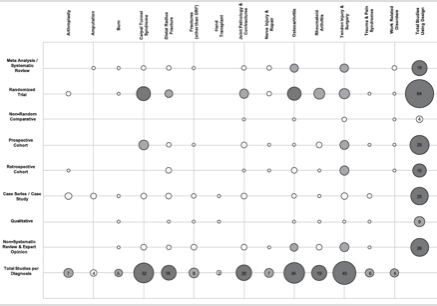Shoulder Special Tests: Are They Really Special? Best way to Evaluate Shoulder Pain
Filed under Uncategorized
Shoulder Special Tests: Are They Really Special? How to evaluate shoulder pain.
By: Emily Saunders
Evaluating Their Clinical Utility
Shoulder pain and injuries are a common concern in clinical settings, and special tests have long been a cornerstone for diagnosing these issues. These tests aim to identify specific shoulder conditions but often fall short in terms of accuracy. Current studies show that orthopedic special tests (OSTs) of the shoulder lack appropriate specificity, sensitivity, and positive and negative likelihood ratios to be clinically useful in guiding clinicians’ evaluations and treatment plans for their patients.
Understanding the Evidence: A Statistics Refresher
When assessing the effectiveness of a diagnostic test, specificity and sensitivity are key metrics. Specificity measures the likelihood that a positive result truly indicates the presence of a pathology, while sensitivity measures the likelihood that a negative result accurately rules out a pathology (Parikh et al., 2008). Ideally, both values should exceed 0.90 for a test to be considered highly accurate. Likelihood ratios, which combine specificity and sensitivity, are also useful. A positive likelihood ratio >10 and a negative likelihood ratio <0.1 are benchmarks for strong diagnostic value (Bosch, 2023; Preneger, 2021).
Limitations of Shoulder Special Tests
Evidence suggests that shoulder special tests often lack the validity needed for effective clinical use in therapy settings (Bélanger et al., 2019; Calvert et al., 2009; Krill et al., 2018; Salamh & Lewis, 2020). The complexity of shoulder anatomy makes it difficult for these tests to isolate specific structures, and the maneuvers performed can exacerbate pain without yielding accurate diagnostic information (Salamh & Lewis, 2020).
For example, the Hawkins Kennedy test, commonly used to assess subacromial impingement, has a sensitivity of 0.80 and specificity of 0.50, while the Jobe test (“empty can” test) has a sensitivity of 0.50 and specificity of 0.87 (Cotter et al., 2018). Tests for biceps pathology, such as the Active Compression test (sensitivity 0.59, specificity 0.57), Crank test (sensitivity 0.49, specificity 0.70), and Speed’s test (sensitivity 0.65, specificity 0.61), also show limited accuracy (Bélanger et al., 2019).
Tests for subscapularis tears, including the bear-hug test, belly-press test, internal rotation lag sign, and lift-off test, demonstrate pooled specificity above 0.90 but sensitivity below 0.60 (Lädermann et al., 2021). For diagnosing AC joint pathology, the Paxinos sign and O’Brien’s test used together produce a positive likelihood ratio of 2.71, which provides only a small clinical impact (Krill et al., 2018).

The Role of Diagnostic Ultrasound
In contrast to special tests, diagnostic ultrasound offers a highly specific and sensitive option for evaluating shoulder pathologies. Reviews indicate sensitivity as high as 0.88 and specificity at 0.98 (Rosas et al., 2017). Other studies show similar ranges, with ultrasound outperforming MRI or MRA in diagnosing rotator cuff tears (Bélanger et al., 2019; Roy et al., 2015).
Salamh and Lewis (2020) recommend that clinicians focus on patient-centered care through physical examinations and clinical interviews rather than relying on shoulder special tests. This approach better accommodates the multifaceted nature of shoulder injuries.
Conclusion
Given the evidence, therapists should reconsider the use of shoulder special tests for undiagnosed shoulder pain. Instead, clinicians can adopt a holistic and evidence-based approach by:
- Conducting thorough clinical interviews to gather detailed patient histories.
- Using evidence-based physical examination techniques tailored to the patient’s symptoms.
- Incorporating diagnostic ultrasound when additional imaging is needed.
By integrating these practices, clinicians can ensure accurate diagnoses and more effective, patient-centered care.
References
Bélanger, V., Dupuis, F., Leblond, J., & Roy, J.-S. (2019). Accuracy of examination of the long head of the biceps tendon in the clinical setting: A systematic review. Journal of Rehabilitation Medicine, 51(7), 479–491.
Calvert, E., Chambers, G. K., Regan, W., Hawkins, R. H., & Leith, J. M. (2009). Special physical examination tests for superior labrum anterior posterior shoulder tears are clinically limited and invalid: a diagnostic systematic review. Journal of clinical epidemiology, 62(5), 558–563.
Cook, C., Beaty, S., Kissenberth, M. J., Siffri, P., Pill, S. G., Hawkins, R. J. (2012). Diagnostic accuracy of five orthopedic clinical tests for diagnosis of superior labrum anterior posterior (SLAP) lesions. Journal of Shoulder and Elbow Surgery, 21(1), 13-22.
Cotter, E. J., Hannon, C. P., Christian, D., Frank, R. M., & Bach, B. R., Jr (2018). Comprehensive examination of the athlete’s shoulder. Sports Health, 10(4), 366–375.
Dakkak, A., Krill, M. K., Krill, M. L., Nwachukwu, B., & McCormick, F. (2021). Evidence-based physical examination for the diagnosis of subscapularis tears: A systematic review. Sports Health, 13(1), 78–84.
Hegedus, E. J., Goode, A. P., Cook, C. E., Michener, L., Myer, C. A., Myer, D. M., & Wright, A. A. (2012). Which physical examination tests provide clinicians with the most value when examining the shoulder? Update of a systematic review with meta-analysis of individual tests. British Journal of Sports Medicine, 46(14), 964–978.
Krill, M. K., Rosas, S., Kwon, K., Dakkak, A., Nwachukwu, B. U., & McCormick, F. (2018). A concise evidence-based physical examination for diagnosis of acromioclavicular joint pathology: a systematic review. The Physician and Sports Medicine, 46(1), 98–104.
Lädermann, A., Collin, P., Zbinden, O., Meynard, T., Saffarini, M., & Chiu, J. C. (2021). Diagnostic accuracy of clinical tests for subscapularis tears: A systematic review and meta-analysis. Orthopaedic Journal of Sports Medicine, 9(9), 23259671211042011.
Parikh, R., Mathai, A., Parikh, S., Chandra Sekhar, G., & Thomas, R. (2008). Understanding and using sensitivity, specificity and predictive values. Indian journal of ophthalmology, 56(1), 45–50.
Perneger, T.V. (2021). How to use likelihood ratios to interpret evidence from randomized trials.Journal of Clinical Epidemiology, 136(2021). 235-242.
Rosas, S., Krill, M. K., Amoo-Achampong, K., Kwon, K., Nwachukwu, B. U., & McCormick, F. (2017). A practical, evidence-based, comprehensive (PEC) physical examination for diagnosing pathology of the long head of the biceps. Journal of Shoulder and Elbow Surgery, 26(8), 1484–1492.
Roy, J. S., Braën, C., Leblond, J., Desmeules, F., Dionne, C. E., MacDermid, J. C., Bureau, N. J., & Frémont, P. (2015). Diagnostic accuracy of ultrasonography, MRI and MR arthrography in the characterisation of rotator cuff disorders: A systematic review and meta-analysis. British Journal of Sports Medicine, 49(20), 1316–1328.
Salamh, P., Lewis, J. (2020). It is time to put special tests for rotator cuff–related shoulder pain out to pasture. Journal of Orthopaedic & Sports Physical Therapy, 50(5), 222-225.
More To Read
Occupation Based Interventions in Hand Therapy
Keeping Occupation Based Interventions in Hand Therapy By: Tristany Hightower Are your treatments occupation based? Do you tailor your activity choices to fit the needs of each patient? As occupational therapists, we should be specialists in creating goals and interventions that are directed at returning our patients to meaningful occupations. Too often, hand therapy can…
Read MoreHand Therapy Interventions for Distal Upper Extremity Injuries and Conditions
Takata, S.C., Wade, E.T., & Roll, S.C. (2019). Hand therapy interventions, outcomes, and diagnoses evaluated over the last 10 years: A mapping review linking research to practice. Journal of Hand Therapy, 32(1), 1–9. Written by Brittany Carrie The Skinny Approximately 26.9% of orthopedic injuries and disorders of the upper extremity occur worldwide. Injuries are most…
Read MorePediatric & Adolescent Shoulder Instability
Lin, K.M, James, E.W., Spitze, E. & Fabricant, P.D. (2018). Pediatric and adolescent anterior shoulder instability: Clinical management of first-time dislocators. Current opinion in pediatrics, 30, 49-56. doi: 10.1097/MOP.0000000000000566. The Skinny: Shoulder instability for pediatric and adolescent patients is fairly common and is often complicated by a high re-dislocation rate. Shoulder instability typically occurs after…
Read MoreSign-up to Get Updates Straight to Your Inbox!
Sign up with us and we will send you regular blog posts on everything hand therapy, notices every time we upload new videos and tutorials, along with handout, protocols, and other useful information.





